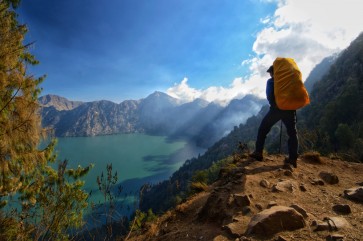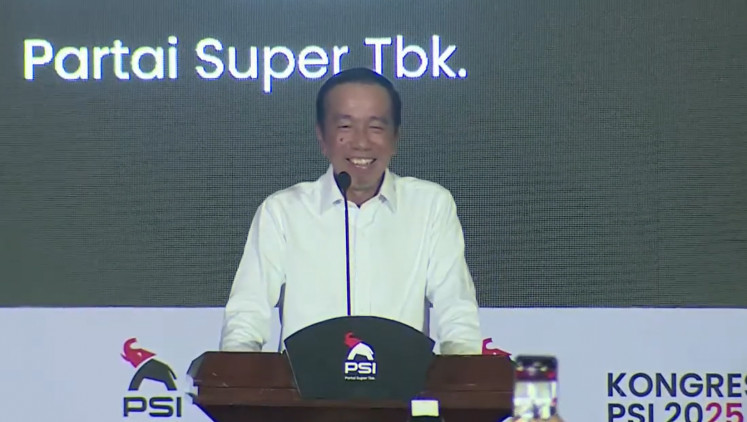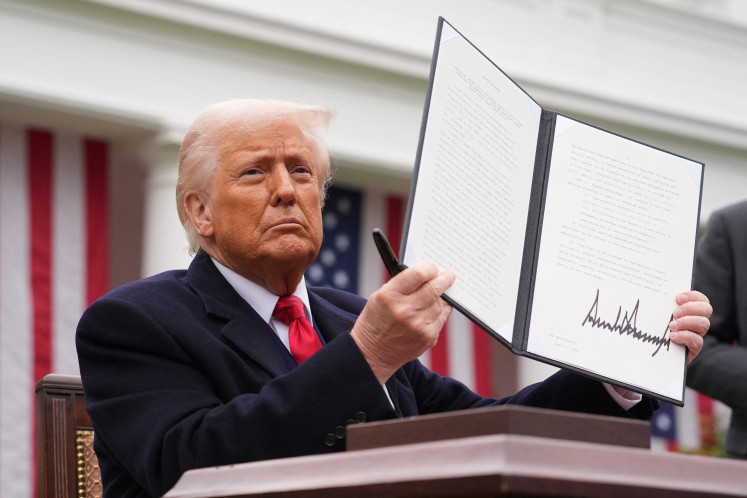Popular Reads
Top Results
Can't find what you're looking for?
View all search resultsPopular Reads
Top Results
Can't find what you're looking for?
View all search resultsSculptors make their mark near Borobudur
Slow process: Sculptors also add a touch of battery acid to enlarge the pores in the stone before charring it with firewood, smearing it with herbs and burying the stone in the ground for a year before proceeding
Change text size
Gift Premium Articles
to Anyone
S
span class="caption" style="width: 230px;">Slow process: Sculptors also add a touch of battery acid to enlarge the pores in the stone before charring it with firewood, smearing it with herbs and burying the stone in the ground for a year before proceeding. (Ganug Nugroho Adi)
In the hamlet of Prumpung in Muntilan, Central Java, several hundred people make their living as sculptors. The craft is traditional: They claim to be the direct descendants those who built Borobudur temple, which lies about 12 kilometers away.
Two men ' Doel Kamid Djajaprana, 73, and his older brother Kasrin Hendroprayono, 74 ' have been the driving force behind the development and refinement of sculpting in the hamlet.
Djajaprana said that he learned how to sculpt from his late father, Salim Djajaprawiro, who sent him as a boy to study the statues of the Buddha that ring Borobudur's many platforms.
Borobudur, built in the ninth century, is the world's largest Buddhist temple and has been named a UNESCO World Heritage Site.
'When we sculpted a bust of Buddha, we didn't know whether it was a sin or not to produce the bust of Buddha,' Djajaprana says. 'We feared it might violate Buddhist teachings.'

In the end, Djajaprana and his friends overcame their uncertainties. 'We were committed to sculpting it. [It] was exactly the same as the bust of the Buddha's head at Borobudur. A buyer from Sumatra purchased our first sculpture for the price of Rp 150.' The amount, about 1 US cent at the current exchange rate, would have been worth around US$20 in the 1950s.
Djajaprana, who founded the Sanjaya workshop in 1960, has received the Upapradana and Upakarti awards from Soeharto and has had many famous customers.
'We owe a lot to Gen. Gatot Subroto, who made us pioneers in sculpting,' Djajaprana says, referring to the famed former Army deputy chief of staff. 'Gen. Gatot had been very impressed with our work, after we made his order for the entrance gate of his villa in Ungaran [Central Java]. He encouraged us to continue.'
As his business flourished, neighbors flocked to his studio to learn how to sculpt from Djajaprana and his brother. Their willingness to share knowledge of their craft led to the development of Prumpung as the center for stone carving in the province.
Many went on to establish their own studios ' there are currently about 20 in the hamlet. The sculptors say they draw inspiration from the majesty of Borobudur, describing it as the source of their faith, art and life.
Yatno, 54, is another sculptor in the hamlet. He says sculpting is a time-intensive process. 'Producing a stone carving will take at least three days and up to six months, depending on its type, size and complexity. All the basic materials are andesite stone from Mount Merapi.'
In Yatno's Kendali Sodo workshop, a legion of various sculptures are on display: miniature temples; statues of Vishnu, Shiva, Buddha, Gupala and Ganesha; stone bowls and mortar and pestles; garden lamps and statue of frogs; fountains and tombstones and more.
Landung, who owns Yoga Brata workshop and employs 10 casual laborers, describes what's popular among buyers. 'Most of the purchasers like to purchase ancient motifs such as temple replicas or Hindu and Buddhist motifs. Recently many craftsmen switched to new designs such as fountains, flower pots and animal shapes.'
'Some order classical statues and historical buildings that will be put into inside or outside hotels, offices, monasteries and even vihara,' Landung says.
At work: Stone for the statues is treated with a variety of materials, including tea, turmeric and gambier, a plant typically involved in preparing betel nuts for consumption.
Another sculptor, Edy, who owns the Kinara Kinari workshop, says many travelers commission pieces directly with the studios, providing their own designs and samples.
Kasrin, the owner of Syailendra workshop, said that he often received orders for Borobudur replicas from Jakarta; Jepara and Semarang, Central Java; and Yogyakarta.
Offering prices vary depending on quality, size and complexity. While garden lamps can cost as little as Rp 100,000, Borobudur reliefs can cost as much as Rp 1.5 million.
Other popular requests include replicas or panels from Angkor Wat in Cambodia, the Shwedagon Pagoda in Myanmar or the Potala Palace in Tibet.
According to another sculptor, Frans Sukoco from Taruna Sakti workshop, a three-meter statue can sell for Rp 35 million.
Visiting the hamlet, visitors will hear the rhythmic sounds of chisels resonating from early morning until dusk.
Stone for the statues is treated with a variety of materials, including tea, turmeric and gambier, a plant typically involved in preparing betel nuts for consumption.
Most of the sculptors also add a touch of battery acid to enlarge the pores in the stone before charring it with firewood, smearing it with herbs and burying the stone in the ground for a year before proceeding.
Sutikno, the secretary of the local office of trade and cooperatives, says that the local government raises about Rp 200 million a month from the work that goes on in the hamlet.
Prumpung hamlet is about 30 kilometers north of Yogyakarta. Despite the town's reputation, it lacks a parking area large enough to accommodate tour buses and many cars. Navigating through the crowded workshops may also be a challenge.
' Photos by Markus Mardius











